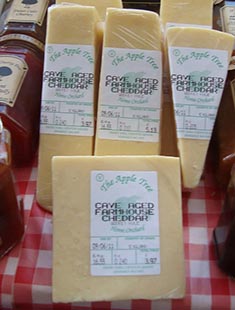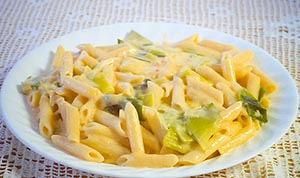Cheddar cheese
Pleasantly flavorful, cheddar is a firm cheese with a sharp bite and melt-in-the-mouth crumbly texture. This classic British cheese is one of the very versatile cheeses, perfect for a platter as a snacking cheese or for use in cooking.
Cheddar preparation and its use originated in medieval times, along the southern slopes of Mendip hills, in Somerset County, in South West England.
Cow milk, raw or pasteurized, is employed to a larger extent in processing cheddar. However, a small quantity of it is also produced by using goat and sheep milk.
 |
| Farmhouse cheddar cheese. Courtesy: rose of academe |
Preparation of cheddar cheese:
Cheddar is prepared from cow's milk. The initial step is to curdle the milk, which is essentially complete within 24 hours, followed by the ripening of the curd to cheese.
To prepare milk curdling, add starter culture to pasteurized milk after heating to 88-90 F in a large container or vat. After about 60 minutes, add rennet or other equivalent curdling agents like vinegar or lemon juice to further set the curd. Allow 30 to 40 minutes to set the curd completely. Gently cut the curd lengthwise with horizontal, followed by vertical wire harps. Allow the curds to heal for 10-15 minutes after cutting. Drain the whey and then allow the fusing together of curd into a solid mass.
In the second step, a solid mass of curds is cut into squares (loaves) and stacked to begin the cheddaring process. Curds are stacked to continue developing acidity until they achieve a pH of about 6.4 and squeeze out additional whey. Again loaves are milled into half-inch pieces.
Next, salt is added to the milled curd for flavor and to stop further acid development. In the final step, the salt-cured curd is filled in cheese molds and pressed to form blocks of cheddar. Cheddar cheese blocks are then inserted in bags for vacuum packaging. Packaged cheese dispatched in storage for aging.
Final cheddar product should be fine and highly pleasing, be firm, and appear solid, smooth, compact, and free from undesirable flavors and odors. Cheese made from pasteurized milk takes twice as long as that made from raw milk to develop the same flavor intensity and ripens more slowly than raw milk cheese.
9 amazing Health benefits of Cheddar cheese
Cheddar cheese is one of the finest sources of cheese wherein almost all nutrients including vitamin B12 are present. A 100g serving of cheddar contains 410 calories and 34g of fat.
It serves as the finest sources of dietary calcium and phosphorus in the American diet. When combined with vitamin D, calcium plays a crucial role in promoting bone strength and growth, particularly in children.
Cheddar provides high-quality protein that is rich in all essential amino acids necessary for growth, development, and maintaining health. A 100g serving of cheddar contains 22.87g, which equates to approximately 41% of the recommended daily intake of protein.
Cheddar cheese contains only a small amount of lactose (0.07 g/oz), making it a suitable dietary source of calcium for individuals with lactose intolerance. During the cheese-making process, nearly all of the naturally occurring lactose in cow's milk is converted into lactic acid, which is easier to digest.
As a dairy product, cheddar cheese is naturally gluten-free. For individuals with gluten sensitivity, such as those with Celiac disease, cheddar serves as an essential source of gluten-free nutrition, offering protein, minerals, and vitamins.
During the ripening process, all the major milk constituents, such as lactose, milk lipids, and milk proteins, undergo biochemical changes into products that are more easily digestible and beneficial for health.
Also, certain volatile flavoring chemical compounds originate while aging as by-products like in cheddar like 2-Isopropyl-3-methoxypyrazine, 3-(methylthio) propanal, p-Cresol, delta-Dodecalactone, Butanoic acid, Isovaleric acid.. etc, which give characteristic "earthy" flavor and sharp, pungent taste to it.
Cheddar is a very good source of fat-soluble vitamins, especially vitamin A. 100g of aged cheddar contains 1242 IU (41.5% of RDI) of this vitamin.
Further, cheddar is a very concentrated source of minerals, especially calcium (71% of RDI), phosphorus (65% of RDI), zinc (33% of RDI), and magnesium.
| Principle | Nutrient Value | Percent of RDA |
|---|---|---|
| Energy | 410 Kcal | 20.5% |
| Carbohydrates | 3.37 g | 2.6% |
| Protein | 22.87 g | 41% |
| Total Fat | 32.5 g | 166.5% |
| Dietary Fiber | 0 g | 0% |
| Vitamins | ||
| Folates | 27 μg | 7% |
| Niacin | 0.059 mg | 4% |
| Pyridoxine | 0.066 mg | 5% |
| Riboflavin | 0.428 mg | 33% |
| Thiamin | 0.029 mg | 2.5% |
| Vitamin-A | 1242 IU | 41% |
| Vitamin-C | 0 mg | 0% |
| Vitamin-D | 24 IU | 6% |
| Vitamin-E | 0 mg | 0% |
| Vitamin K | 2.4 µg | 2% |
| Electrolytes | ||
| Sodium | 653 mg | 43.5% |
| Potassium | 74 mg | 1.5% |
| Minerals | ||
| Calcium | 710 mg | 71% |
| Copper | 0.030 mg | 3% |
| Iron | 0.14 mg | 2% |
| Magnesium | 27 mg | 7% |
| Manganese | 0.027 mg | 1% |
| Phosphorus | 455 mg | 65% |
| Zinc | 3.64 mg | 33% |
Buying
Choose cheddar cheese that is neither dried out nor too crumbly. Cheese experts judge the quality of cheddar by certain yardsticks while making it: raw cow's milk, pasteurization, cheese cultures used, coating, age, etc.
Varieties of Cheddar differ greatly from each other in terms of both taste and color of cheese produced. Sometimes spices and herbs are added to improve the flavor, color, and shelf-life of cheddar. Common herbs and spices and other flavors added to cheddar include paprika, black peppercorns, caraway, parsley, dill, tarragon, annatto, and sundried tomatoes.
At stores, choose AA-grade, highly pleasing cheddar with even color, consistency, and a firm rind without any surface cracks. Check for the interior close to the rind, and it should not be darker. It should not taste spoiled and out of flavor.
English farmhouse cheddar is a countryside cheese made by farmhouse owners who employ ancient traditional techniques. They use their own herd's unpasteurized milk, hand-cheddared, molded-in cloth-bound, and aged in caves for months to form a natural rind.
Storing
Cheddar is one of the safest cheeses since it uses starter cultures while making and has pH values of less than 5.6. According to the researchers at Wisconsin Center for Dairy Research, University of Wisconsin, cheddar will not support the growth of L. monocytogenes at 4-30° C after the opening of the packages.
At home, cheddar will stay well in the fridge for 2 weeks. Remove cheddar from the fridge for at least 30 minutes before eating it in order to enjoy its flavor and taste.
Here are some serving tips:
Being a firm cheese, cheddar can withstand higher temperatures in particular when used for topping. It is also used grated in cooking.
Raw milk cheddar made and aged in the traditional way tends to have a sharp, biting flavor, often slightly "earthy". |
| Leek & cheddar pasta. Courtesy: Kurt Bauschardt |
Cheddar complements well with seasonal vegetables and herbs. It is best used in soups, appetizers, pasta, pizza, quiches, tarts, and rice dishes like risotto.
In appetizers and sweets, it mixes well with bread and can make delicious cakes (cheesecakes) and desserts.
Prepare creamy zucchini, potato & cheddar soup seasoned with thyme herb, and cauliflower cheese soup.
Prepare apple pie with crusty cheddar cheese for dessert, OR savory new potato, spring onion & Montgomery cheddar quiche.
Lángos is a Hungarian fried raised bread smeared with garlic, and sour cream sauce and topped with grated cheddar cheese.
Safety profile
Cheddar cheese is among high salt and saturated fats containing dairy products. Eat it in moderation.
Cheeses, including cheddar, are high in tyramine content, and if a person on Mono-amine oxidase inhibitors (MAOI's) medication like Phenelzine (Nardil) consumes cheeses, he may develop a medical emergency known as "hypertensive (high blood pressure) crisis" which have symptoms like severe headache, sweating, nosebleeds, fast heartbeat, chest pain, blurring of vision, shortness of breath, and confusion, and should seek immediate medical attention. Also, they need to continue following a low-tyramine diet for a few weeks after stopping these medications. (Medical Disclaimer)
Source: Mayo clinic: MAOI's and diet.
Also read ≻≻-
≻≻- Cottage cheese nutrition facts.
≻≻- American Cream cheese nutrition facts.
≻≻- Back to Dairy products from Cheddar cheese nutrition facts.
≻≻- Back to Home page.
Further Resources:
USDA National Nutrient Database. (opens in new window).
West Country Farmhouse Cheddar. (opens in new window).
Cheddar-Grades and Standards. pdf. (opens in new window).